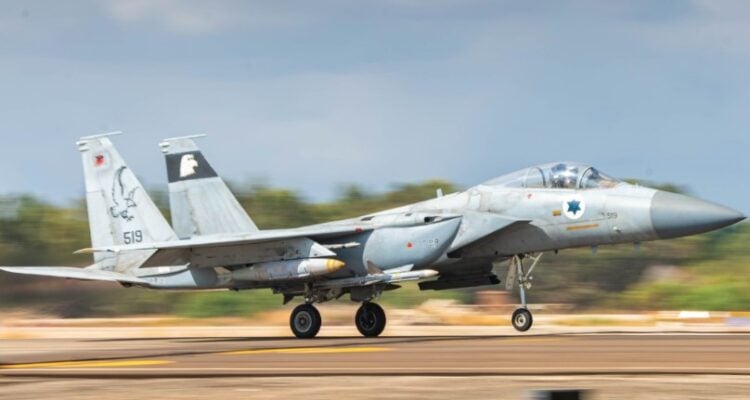The IDF is committed to the goal of destroying infrastructure built by Radwan next to the border, as part of the broader goal of dismantling Hezbollah’s military-terrorist presence in southern Lebanon.
By Yaakov Lappin, JNS
The Israeli Air Force has significantly escalated its offensive operations against Hezbollah’s launch capabilities, focusing on degrading the Iran-backed terror army’s missile and rocket arsenal.
Over the past few days, the IAF has conducted a series of strikes, involving large jet formations of around 150 aircraft, aimed at Hezbollah’s launch infrastructure, including missile sites embedded within civilian areas.
Hundreds of launchers comprising thousands of launcher barrels have been destroyed in each such wave. This campaign marks a decisive shift in Israel’s approach to neutralizing the Hezbollah threat to its home front.
An Israeli military source declined to share an estimation of the degree of degradation of Hezbollah’s capabilities thus far achieved, explaining that such figures would be valuable to the Iranian proxy group.
The source emphasized that the campaign was ongoing.
On Sunday, IDF Chief of Staff Lt. Gen. Herzi Halevi outlined the military’s new approach during a statement from the Tel Nof Airbase near Gadera. Halevi emphasized the IDF’s increased readiness and the necessity of sustained strikes to neutralize Hezbollah’s capabilities.
“The IDF has recently raised its readiness to the highest level,” said Halevi. “Last Friday, we struck the chain of command of Hezbollah’s elite force—the Radwan Force—and also their senior commander, Ibrahim Aqil, was eliminated. This was a very important capability in the Hezbollah terrorist organization, I know how much it shakes up the organization,” he said.
Hezbollah’s Radwan Force, a special operations unit tasked with executing offensive ground operations against Israel, has spent years planning a mass murder and kidnap attack targeting the Galilee—a plan that Hamas copied and applied to the western Negev on Oct. 7.
The IDF is committed to the goal of destroying infrastructure built by Radwan next to the border, as part of the broader goal of dismantling Hezbollah’s military-terrorist presence in southern Lebanon.
In his remarks, Halevi stressed the preemptive nature of the strike, noting that Aqil and his commanders had been planning attacks against Israeli civilians and soldiers.
“For years these commanders had been making plans to conquer the Galilee,” he added. “They were planning how to execute the next attack, and it is possible that they were working on that very plan in the meeting on Friday afternoon.”
In parallel to the targeted elimination of Hezbollah’s senior leadership members, the IAF has focused on dismantling Hezbollah’s missile launch sites.
Israeli defense officials said the IAF had launched extensive strikes on Hezbollah’s fire systems following intelligence that the Lebanese terror organization was preparing to fire at Israeli territory.
“About an hour ago, following indications that Hezbollah was preparing to fire towards Israeli territory, we began conducting extensive strikes on terrorist targets throughout Lebanon,” IDF Spokesperson Rear Adm. Daniel Hagari stated on Monday morning.
As of 12:30 in the afternoon, Israel had struck some 300 Hezbollah targets across Lebanon, according to Channel 12 News.
The IAF’s approach has prioritized preemptive strikes to disrupt Hezbollah’s ability to launch missiles and rockets from within civilian areas. Hezbollah, according to Israeli intelligence, has embedded its missile infrastructure inside large numbers of southern Lebanese villages, turning civilian homes into military assets.
The official revealed details of one of Hezbollah’s concealed missile systems, a Russian-made DR-3 cruise missile which he said had a 300-kilogram warhead and a flight range of up to 200 kilometers.
The missile had been hidden inside a civilian home, and Israeli air surveillance identified preparations to launch it, including the knocking out of a side wall.
“We immediately launched a precise strike on that house,” the official noted, adding that the strike eliminated both the terrorists and the missile moments before it could be launched. The missile had a 300 kilogram (661 pound) warhead and a range of 200 kilometers (124 miles), he said, putting almost all of Israel in range.
Hezbollah has ramped up its fire toward northern Israel, sending residents into bomb shelters and prompting mass evacuations—but has been unable to fire at the scale it wanted to due to Israel’s preemptive strikes, according to Israeli assessments.
The source said it had fired some 150 projectiles on Sunday, but had intended to fire many more. This is due to the fact that we “operating to eliminate the threat when we see it. We are not waiting for the rockets to be launched at Israel. We’re attacking preemptively, and…we are doing it extensively in the last couple of days,” the source said.
The military official confirmed that Hezbollah had fired more than 8,800 rockets, missiles and unmanned aerial vehicles (UAVs) toward Israel since Oct. 8, when it joined the war in support of Hamas.
The strikes have forced over 60,000 Israelis to evacuate from northern communities, severely impacting daily life in the region.
Defense Minister Yoav Gallant, during a visit to the IDF’s Northern Command on Sunday, described the past week as “the most difficult in the history of Hezbollah’s existence.”
Gallant emphasized the importance of ensuring the safe return of Israel’s northern communities, a key objective of the IDF’s ongoing operations.
During his own remarks from Tel Nof Airbase, Lt. Gen. Halevi confirmed that the IDF has systematically weakened Hezbollah’s capabilities.
“For months, we have been weakening the capabilities Hezbollah has built up over decades, layer after layer, focusing on its launch and combat capabilities,” said Halevi.
Since Oct. 8, Hezbollah has lost more than 600 terrorists, including senior military leaders within Hezbollah’s command structure.
In parallel with the airstrikes, the IDF has taken steps to minimize civilian casualties by issuing advance warnings to Lebanese civilians living near Hezbollah’s missile sites.
“We advise civilians from Lebanese villages located in and next to buildings and areas used by Hezbollah for military purposes, such as those used to store weapons, to immediately move out of harm’s way for their own safety,” said IDF Spokesperson Hagari on Monday.
“We are aiming only at the capabilities on the rockets, on the missiles, on the launchers,” he stated.
The IAF’s aerial campaign shows no signs of slowing, with further strikes planned in the coming days.





